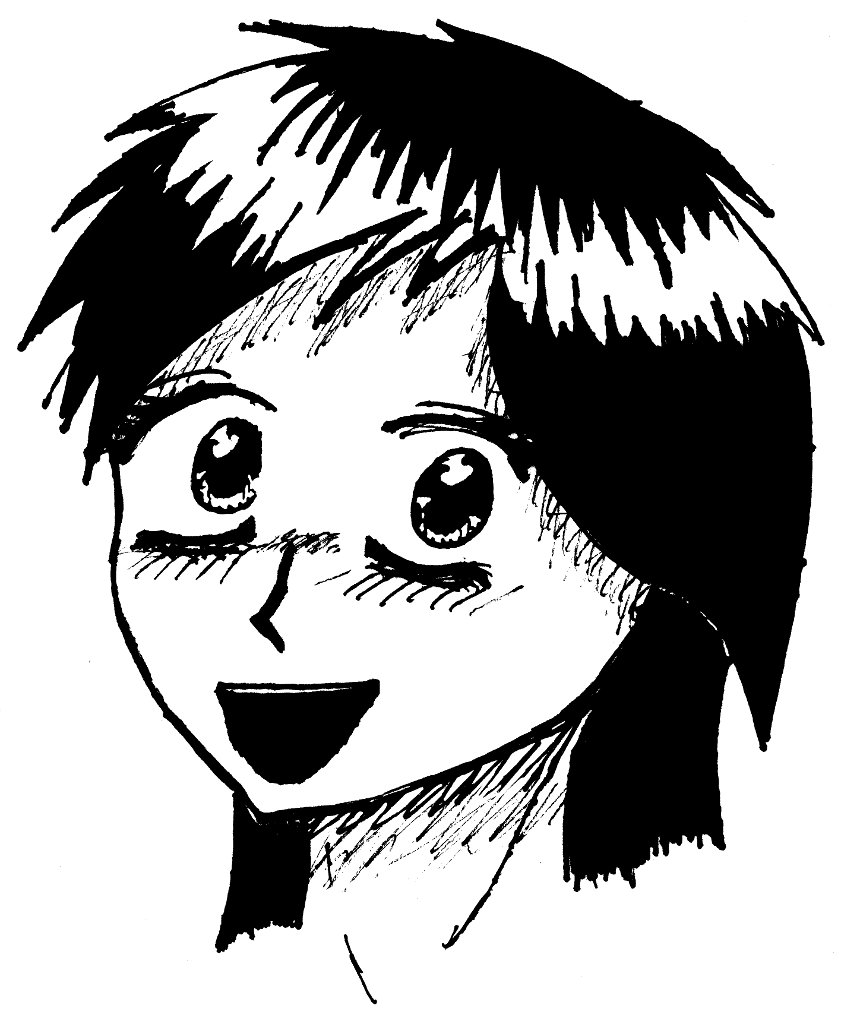 This is a different head that the one mentioned in the previous post. However, I think I’ve settled into a proper method for scanning things in to be coloured digitally.
This is a different head that the one mentioned in the previous post. However, I think I’ve settled into a proper method for scanning things in to be coloured digitally.
For those interested in the process (I use GIMP);
- Scan in work, with the Color Mode set to Color (Photo). You can mess about with the Auto-Tone all you like.
- Create a Layer and name it Backdrop, and completely fill it with whatever color you usualy use. Some people use white but it’s not reccomended (white doesn’t allow you to see what’s transparent if you plan on coloring things white in the image). I use a very light green which I never use for anything else. Helps when it gets to the coloring stage.
- Create a third Layer and name this one Lineart. This one should be completely transparent. If you haven’t already, the order from top to bottom should be Background (the default name for any scanned image), Lineart, and Backdrop.
- Add a black Layer Mask to the Lineart Layer.
- Desaturate the Background Layer.
- Copy the contents of the Background Layer and paste it into the black Layer Mask. It helps if you right click on the Layer Mask and set it to Show Layer Mask. Also, to see what you’re doing, you’ll want to turn off the visibility of the Background Layer.
- Invert the colors in the Layer Mask.
- Fill the Lineart Layer completely with black. You may want to deselect Show Layer Mask.
- Apply a Threshold to the Layer Mask. In this case, to really observe what the different levels do, you shouldn’t reshow the Layer Mask.
- By now, you really don’t need the Background Layer any more, so feel free to either delete it, or if you want to keep the original scan, just shove that Layer beneath all of the others.
- Now you can go ahead and right click on the Lineart Layer and hit Apply Layer Mask. This will finalize the mask. If you temporarily turn off the visibility of your Backdrop (and Background, if you still have it) Layers, you should notice that the Lineart is now comprised of your outlines, which are black, and the stuff that isn’t black is transparent.
- Finally, there’s inevitably going to be some bits that you have to manually go back and fix, be it erasing some black or filling in some blank areas. Use the Pencil Tool for that. It’s best.
- UPDATE: Another really good way to eliminate the pixels of “dust” that usually will be found in your piece is to select all the black with the Select by Color Tool, to go into Select → Grow and Grow it by one pixel, then Select → Shrink and do that be two pixels. this will eliminate most of the little gaps inside the lineart. If there’s extra “dust” spilling out onto the areas where it’s supposed to be clear, do the same and just Select the Transparent areas.
- UPDATE: Something else I found: if you need to go over lineart again but want to retain it’s hand-drawn appearance, checking the Apply Jitter box works quite nicely. Also, don’t forget straight lines can be done easily by holding down the Shift key.
—
- Now is where you can add a Flat Color Layer between the Lineart and Backdrop Layers, and you can get down to coloring. But that explanation/tutorial is for another day
—
Here’s where I’ll stop off. The next how-to will explain how to properly color your image. If you like your stuff in B&W, you can just stop here.